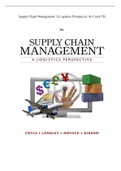Samenvatting
Summary Endterm Consulting Methods - Flawless Consulting by Peter Block
- Instelling
- Universiteit Van Amsterdam (UvA)
- Boek
- Flawless Consulting
Summary for the endterm of the course 'Consulting Methods'. Includes chapter 1-10 and 12-17 of the book 'Flawless Consulting' by Peter Block.
[Meer zien]














